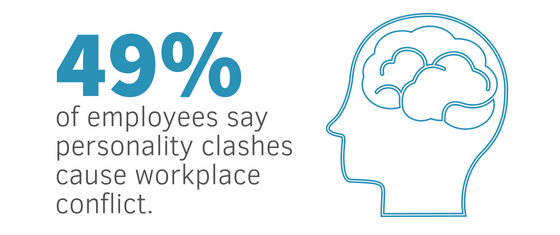We love hearing about the ‘unintended consequences’ of employee engagement, and one of them is this: When you’ve cultivated a highly engaged organization, you’ll quickly realize:
- Your employees have passionate opinions – because they care so much about what they do.
- Your employees interact with each other more, work more closely together, and often build friendships that extend beyond the office walls.
These are wonderful outcomes of engagement, but they also come with complications. And, they’re two reasons (of many) why conflict management and communication are crucial to keeping your engaged team running smoothly.
Conflict Basics: Conflict Doesn’t Have to be a Bad Thing
Conflict isn’t something to be eliminated – it’s a natural part of any relationship. And, when you can address conflict quickly, informally, and collaboratively, it can actually strengthen relationships. In fact, conflict can yield opportunities to improve that you’d never have unearthed otherwise. The secret to turning conflict into a positive stage of growth, however, is communication.

Conflict Management 101: Passionate Opinions
The goal of engagement is for employees to feel emotionally invested in their work and your business, and with that passion can come conflicts. Everyone cares – a lot! (CEO’s included!)
Providing employees with a regular opportunity to provide anonymous feedback is one way to prevent passionate opinions from escalating into conflict (and sliding into disengagement), but only when management is committed to taking that feedback and following through with a response, and when appropriate, action.
That avenue for open communication is important and it’s equally important to make employees feel heard. You can address concerns in meetings, or respond to anonymous EM survey respondents within the app (all the while maintaining their anonymity), so they know you’re listening and valuing what they have to say.
The other key component to handling passionate opinions is that when you do respond, don’t automatically respond with “no.” If you shut down employee suggestions, they won’t be motivated to try to think creatively when you need them to – because if the answer is always “no,” why try?
A more productive way to respond to suggestions is to inform the employee of the circumstances leading to the decision or way of doing things, so they understand what constraints you’re under, and let them know you’re committed to finding a resolution to the issue with some creative, collaborative thinking. You might find that they can come up with a solution you didn’t see before.
Conflict Management 102: Personal & Professional
When employees connect personally as well as professionally, that can lead to some of the most innovative ideas and closest teamwork, but it can get a little complicated. If colleagues have issues with each other that are more personal than professional, those emotional conflicts can disrupt the positive work environment you’ve worked so hard to create.
A Gallup “State of the American Workplace” study states,

Ideally, everyone will behave like adults and manage their personal conflicts privately and professionally. But, that isn’t always the case. Some situations are decidedly sticky – and for the stickier ones, it may well be worth bringing in a professional mediator so the parties involved can air their grievances, feel heard, and be given tools and support to move past the conflict.
But, for minor conflicts, you might want to try informally speaking with each person individually, hearing their side of the story, asking what support they need to do their best work (maybe you can separate their duties into different teams or departments) and suggesting behavioral modifications if one or both employees is out of line.
The Best Conflict Management: Prevention
The best conflict management is prevention by open, honest, and frequent communication between employees and management. These frequent and early ‘check-ins’ that happen with a regular anonymous survey can alert you to conflicts before they escalate into doing real harm to the camaraderie of your workforce.
And, when you respond to employees with the intent to support them in doing their best work, it’s remarkable how much more smoothly everyone can work together.



